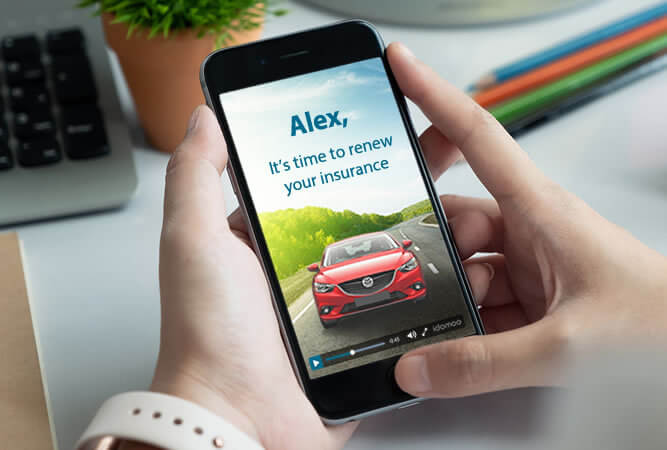When 80% of consumers are more likely to make a purchase if a brand offers personalized experiences, the importance of personalization can’t be ignored. Businesses that hope to break through the noise and effectively connect with their customers are quickly learning that personalized content is the key.
But first, let’s set the foundation.
What Is Personalized Content?
Personalized content leverages customer data to deliver a brand experience that is unique to each consumer. A one-size-fits-all approach gets lost in the digital noise, with 71% of consumers expressing frustration when a shopping experience is impersonal.
Your customer wants to be treated like a unique individual, not a number. Personalized content incorporates consumers’ distinct characteristics and, in the process, becomes significantly more meaningful and relevant for them.
Interested in how it works? Here are some real-world examples of personalized content plus inspiration for you to use it with your audience.
8 Places to Find and Use Personalized Content
Personalized content covers all digital media — even video — and almost every industry you can think of, from the obvious ones (looking at you, retail) to the less obvious. (When was the last time your utilities provider sent you a personalized note?)
While the lineup below isn’t an exhaustive list of every place you can find personalized content, it will give you a thorough introduction to where you can leverage content personalization to wow your customers.
1. Dynamic Social Media Content
One of the most popular sources for personalized content is social media. From Instagram’s Explore tab to TikTok’s For You page, most platforms have a function where they curate posts for each individual using an algorithm that analyzes user activity.
Some platforms even share personalized roundups for users, adding data points to quick videos to create unique (and shareable) compilations. Facebook’s Friendship Anniversaries roundups and Snapchat’s Recaps are notable forms of this.
As a result, users now expect personalized content on social media. They’ll hide or mark posts as irrelevant to optimize their experience. Scrambling to stay in front of their customers, brands have had to prioritize personalization in their social media strategies.
Luckily, social media is a gold mine of customer information. You can use that data to tailor your message to your audience. For example, advertisers can leverage Dynamic Video Ads to add segmentation data to video scenes, creating customized ads that are more relevant to the viewer.
Here’s an example from O2, you can see how the video changes based on the user’s device and interest. Dynamic ads like these get up to 7x return on ad spend simply because they’re more engaging and more targeted for the individual.
Of course, targeted content on social media crops up in more than just advertising and curated feeds. Social media allows for direct interaction with the consumer, and what could be more personal than that? Take TikTok, for example. The stitching feature (here’s an example) has allowed countless brands to reply directly to their target audience with relevant content.
The big takeaway here is that social media is a great opportunity for leveraging consumer data to create more personalized experiences, but be sure to do it in such a way that adds value for the consumer.
Cadbury executed this perfectly with its Cadbury Glow campaign. They had customers connect their Facebook accounts in order to create Personalized Videos that incorporated photos and names pulled from their profile. The videos were then sent as mementos to friends and family.
This is just one example of letting customers opt in to share their data to enjoy a more personalized customer experience.
2. Personalized Emails
Ever suffered from an overflowing inbox? These days, email is often characterized by quantity rather than quality. To avoid spending all day reading every message, consumers have learned to quickly scan and identify what is relevant to them.
To avoid being ignored, many brands have turned to personalization. While generic emails are easy to discard, messages that highlight a personal connection or relevant detail often attract the attention of even the busiest customers.
Personalized emails can sometimes be as simple as putting thought into the email subject line. Experian found that, compared to other promotional mailings, personalized subject lines achieved:
- 27% higher unique click rates
- 11% higher click-to-open rates
- More than 2x the transaction rate
But personalized subject lines are just the tip of the iceberg. The content of the actual email can also be optimized with customer data. For instance, an email that highlights a player’s gaming stats and invites them back to beat their record would be much more effective than a generic reminder to play.
Retailers have been leveraging customer data for more personalized emails for years. They often send recommendations based on past purchases. Not only does this guarantee that the message is relevant, but it also encourages the customer to trust the brand’s messages.
But this happens in other industries too. We’ve known several utility companies reach out with personalized content via video email marketing, such as tips for saving on energy.
Ultimately, including details that pertain to the recipient can increase open rate, especially when included in the subject line, and click-through rate. Over time, your email subscriber will grow to expect personalized content from you and be more inclined to open and read your emails.
Remember: It’s not just the subject line that influences open rate. The sender (your brand) matters too. Make sure your subscribers know you always include relevant content just for them.
If you want your customers to pay attention to you, you need to show that you’ve paid attention to them as well.
3. Video Personalization
Businesses have long used video to communicate with their customers. From TV commercials to social media content, the medium has been an effective way to show a brand’s message versus just telling it.
Historically, marketers have seen video as part of a time-consuming, costly production process. And that meant video content was designed to appeal to as many people as possible.
Today, it’s different. Companies can easily personalize videos for each of their unique customers, merging CRM data and other data sources with video scenes so they’re dynamic. With Living Video, they can even update in real time from live data feeds (such as retail inventory, for one), constantly evolving to show viewers the latest info.
With personalized video content, you can have one master video with millions of variations, adding in new scenes or data points (or removing them) based on who will be watching.
Like with most things, it’s easier to show than tell. Here’s an example from Ubisoft.
The Ubisoft Connect Wrap-Up campaign included data-driven videos for nearly 5 million players. Each customer receives a dynamic video, with the content personalized just for them.
A bonus benefit to Personalized Videos? Shareability! People love sharing videos, especially when it includes information about themselves. As a result, these kinds of campaigns are incredibly effective at boosting brand reach and exposure.
4. Personalized Offers
Offers — discounts, deals, gifts and more — that strategically draw from customer data are also examples of personalized content. Brands have turned to personalized offers because of how much more effective they are at getting results. It’s a no-brainer that consumers are more responsive to offers that are unique and relevant to them.
A popular form of this that you’ve probably seen is birthday offers or gifts. By acknowledging such a personal event, the brand strengthens its relationship with the customer while also boosting engagement and sales.
Here are two of the most common ways brands leverage personalization in their offers.
- Basing it on customer activity: “Here’s a coupon for that item you had in your cart!”
- Referencing loyalty: “Thanks for being a member for two years! Here’s an exclusive deal for just you.”
This example from Foxy Bingo encourages Maria to claim her reward. Note the other personalized content details throughout the video. It’s similar to our gaming example above but has a personalized call to action as well.
5. Online Quizzes and Calculators
Personalized content and interactivity often go hand-in-hand. After all, what’s more bespoke than something you’ve interacted with or customized yourself?
Online quizzes and calculators that allow customers to interact and input their information are also a helpful way to collect valuable first-party data. Those insights can then be used to create a more personalized experience for the customer.
Product recommendation quizzes are a common form of this that you may have seen. Here’s an example from popular retailer Sephora. Brands typically ask customers a few questions about their needs and lifestyle and then recommend products best suited for that customer.
Online calculators follow a similar concept and work particularly well for businesses that offer custom solutions and prices. Interested consumers can input their data to receive a custom quote or information with a click of a button.
Check out the mortgage calculator below, which uses Living Video capabilities to allow for interactivity, generating a new video in real time based on the customer’s data.
By adding a level of interactivity, brands not only provide customers with a fun and engaging activity, but they’re able to gather insights that enable them to deliver a more personalized customer experience.
6. Apps
Apps are another common channel for personalized content. There’s a reason so many of them ask you to make an account in order to use it. In contrast to a mass of anonymous users, apps that can identify unique users can design more personalized experiences for their customers.
Social media platforms, as mentioned, are experts at this, but even other kinds of apps leverage personalization. Banking apps often analyze spending information, creating personalized reports and offering advice for improving spending habits. Travel and hospitality apps may send out tips and recommendations for their customers for trips they have planned.
Wellness apps can use personalized data to help customers, surfacing valuable insights with at-a-glance simplicity.
Even something as simple as a photo storage app can create personalized content. Google Photos does this with its Spotlight and Recent Highlights feature. By regularly compiling photos into themed collections, the app delivers memorable content to its users that is relevant, engaging and shareable.
7. Customer Service Resources
According to Epsilon, 32% of consumers interpret personalization as service. This was one of two of the top interpretations, so it’s not surprising that customer service can elevate the customer experience. While it’s not the most exciting example of personalized content, customer service is a common use case for personalization.
For a customer with concerns, the most helpful resources are the ones that address your situation perfectly. Generic introductory how-tos or FAQs are good to have, but they also lack the personal details and human element that can turn a bad customer service experience into a positive one.
That’s why companies are turning to personalized content for better customer service. This onboarding video by SelectHealth shows how customer data can be used to provide more helpful content.
By including only relevant details, the insurance company was able to deliver a much more personalized and informative welcome, starting the relationship off right.
Bonus: Effective digital customer service solutions also ease the load on customer service representatives. We’ve seen Personalized Video drive down call center volume as much as 73%.
8. Microsites and Landing Pages
Websites are another place you’ll often find personalized content. Microsites and landing pages, in particular, lend themselves to customization for a specific audience or purpose. This makes them great places for hosting personalized content.
Often used in combination with the channels mentioned above, the possibilities with microsites and landing pages are endless. You could send an email link to a microsite that makes purchasing personalized recommendations easier or create a landing page that displays an exclusive offer.
Of course, these pages can also host Personalized Videos. A university, for example, could create a unique landing page for admitted students that displays a fun, personalized acceptance video like the one below, along with important personal details that the student would need to know.
Where Personalized Content Fits Into Your Business
So there you have it. Personalized content can show up all over the web and connected apps, from social media to email to video. It’s a great way to capture attention and stir emotions, adding a personal touch to the brand-customer relationship.
Want to reach your customers — personally? We help brands add personalization to immersive video scenes that have increased conversions by 8x and engagement over 10x. You can repurpose video content, take advantage of our templates and more. The important part is to communicate with your customers in a way that’s effective, and that’s what our open Personalized Video platform does.
We can walk you through all the ways personalization combined with video content can amplify your business. Contact us today for a free demo!





